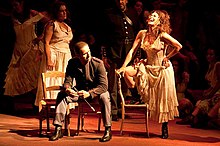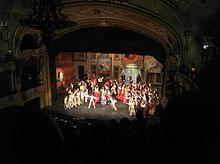
Carmen is an opera in four acts by the French composer Georges Bizet. The libretto was written by Henri Meilhac and Ludovic Halévy, based on the novella of the same title by Prosper Mérimée. The opera was first performed by the Opéra-Comique in Paris on 3 March 1875, where its breaking of conventions shocked and scandalised its first audiences. Bizet died suddenly after the 33rd performance, unaware that the work would achieve international acclaim within the following ten years. Carmen has since become one of the most popular and frequently performed operas in the classical canon; the "Habanera" and "Seguidilla" from act 1 and the "Toreador Song" from act 2 are among the best known of all operatic arias.
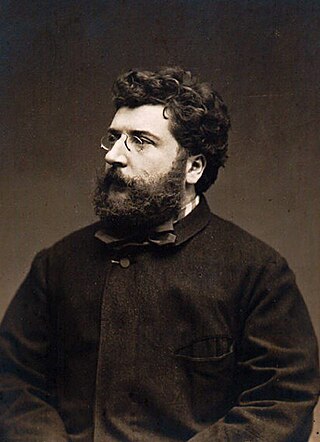
Georges Bizet was a French composer of the Romantic era. Best known for his operas in a career cut short by his early death, Bizet achieved few successes before his final work, Carmen, which has become one of the most popular and frequently performed works in the entire opera repertoire.
Entr'acte means 'between the acts'. It can mean a pause between two parts of a stage production, synonymous to an intermission, but it more often indicates a piece of music performed between acts of a theatrical production.

André Caplet was a French composer and conductor of classical music. He was a friend of Claude Debussy and completed the orchestration of several of Debussy's compositions as well as arrangements of several of them for different instruments.
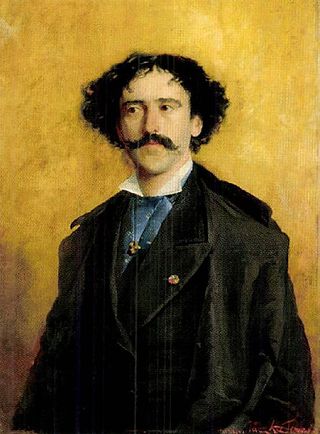
The Carmen Fantasy, Op. 25, by Pablo de Sarasate is a fantasy on themes from Bizet's Carmen for violin and piano or orchestra, composed in 1881. A version with piano accompaniment was published in 1882. It was dedicated to Joseph Hellmesberger.

Ernest Guiraud was an American-born French composer and music teacher. He is best known for writing the traditional orchestral recitatives used for Bizet's opera Carmen and for Offenbach's opera Les contes d'Hoffmann.
In a musical context, an Aragonaise is a "dance of Aragon". This is a driving triple metre dance which is traditionally accompanied by guitars, castanets and hand clapping.
Habanera is the popular name for "L'amour est un oiseau rebelle", an aria from Georges Bizet's 1875 opéra comique Carmen. It is the entrance aria of the title character, a mezzo-soprano role, in scene 5 of the first act.

Henri-Gustave Casadesus was a violist, viola d'amore player, composer, and music publisher.

L'Arlésienne is incidental music composed by Georges Bizet for Alphonse Daudet's drama of the same name, usually translated as The Girl from Arles. It was first performed on 30 September 1872 at the Théâtre du Vaudeville in Paris. Bizet's original incidental music consists of 27 numbers for chorus and small orchestra, ranging from pieces of background music (mélodrames) only a few measures long, to entr'actes. The score achieves powerful dramatic ends with the most economic of means. Still, the work received poor reviews in the wake of the unsuccessful premiere and is not often performed now in its original form, although recordings are available. However, key pieces of the incidental music, most often heard in the form of two suites for full orchestra, have become some of Bizet's most popular compositions.
IllumiNations was a series of nightly fireworks shows at Epcot before IllumiNations: Reflections of Earth was created in 1999 for the Walt Disney World Millennium Celebration.
The Toreador Song, also known as the Toreador March, is the popular name for the aria "Votre toast, je peux vous le rendre", from the French opera Carmen, composed by Georges Bizet to a libretto by Henri Meilhac and Ludovic Halévy. It is sung by the bullfighter Escamillo as he enters in act 2 and describes various situations in the bullring, the cheering of the crowds and the fame that comes with victory. The refrain, "Toréador, en garde", forms the middle part of the prelude to act 1 of Carmen.
L'histoire de Manon, generally referred to as Manon, is a ballet choreographed by Kenneth MacMillan to music by Jules Massenet and based on the 1731 novel Manon Lescaut by Abbé Prévost. The ballet was first performed by The Royal Ballet in London in 1974 with Antoinette Sibley and Anthony Dowell in the leading roles. It continues to be performed and recognised internationally.
Selected discography of recordings conducted by Thomas Beecham:

Carmen: Duets & Arias is an album released in 2010 by Italian tenor, Andrea Bocelli. The album is a collection of arias of Georges Bizet's opera Carmen, including duets with Welsh bass-baritone, Bryn Terfel, Russian mezzo-soprano Marina Domashenko, and Italian soprano Eva Mei, from the French opéra comique.
The Belgian-born French conductor André Cluytens (1905–1967) was a prolific recording artist. His recording career ran from May 1943 to December 1965. Many of Cluytens recordings have since been re-issued.

Paul Lacombe was a Languedocien (French) composer and pianist.
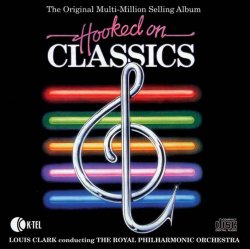
Hooked on Classics, produced by Jeff Jarratt and Don Reedman, is a multi-million selling album recorded by Louis Clark and the Royal Philharmonic Orchestra, published in 1981 by K-tel and distributed by RCA Records, part of the Hooked on Classics series.

Hooked on Classics 2: Can't Stop the Classics is an album by Louis Clark and the Royal Philharmonic Orchestra, published in 1982 by K-tel, part of the Hooked on Classics series.
